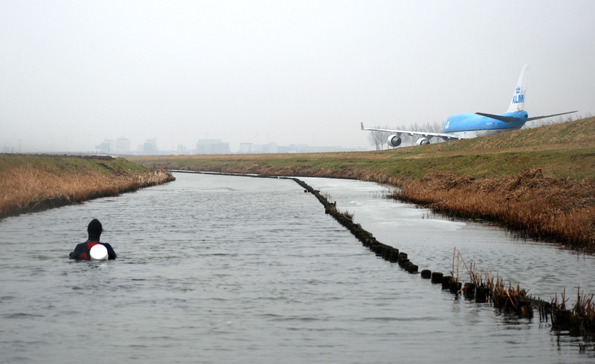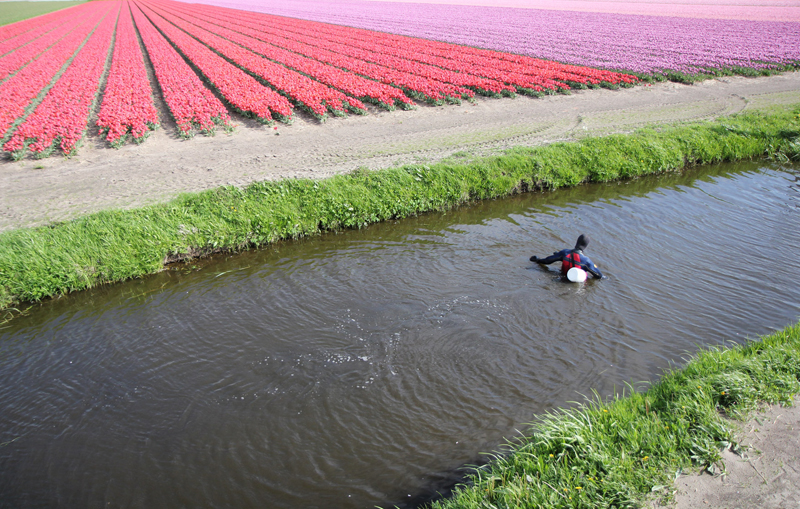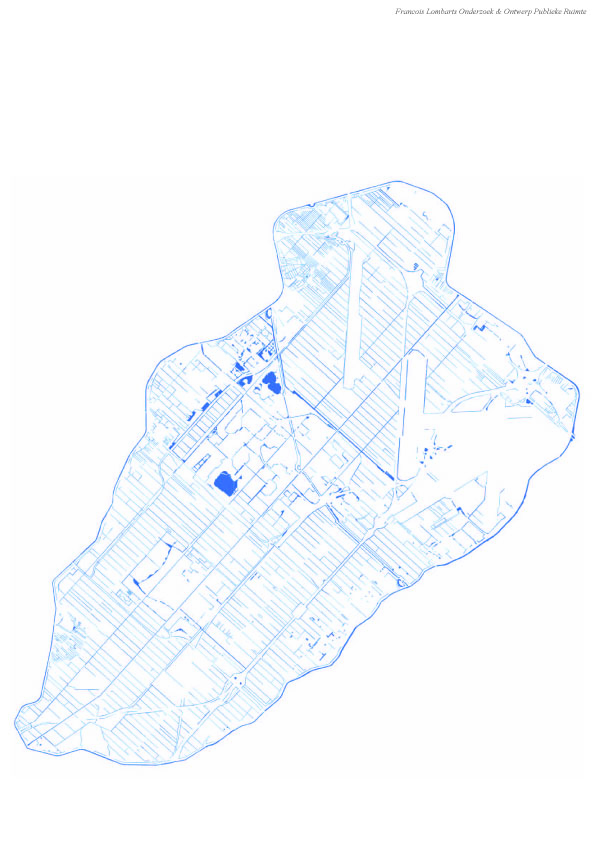Francois Lombarts: 'Ik wil inpolderen!'
| 2013-02-25 11:31:10
'Ik wil inpolderen!' (werktitel)
'Stellingname' 7 april - 23 juni 2013:
Als een vorm van fysiek denken verkent ontwerper Francois Lombarts de polder zwemmend om de identiteit bloot te leggen. Hij dringt door in alle waterwegen die als aders en haarvaten het leven van deze polder definiëren. Kanalen, sloten en greppels vormen samen met zijn eigen fysieke beperkingen en de functionele barrières in de polder zijn Hollandse werkterrein. Het resultaat vatte hij samen in het videowerk 'Sinking into the landscape' (2013, 12 min).
Met dank aan Ritse Mol.
Lombarts: 'I could not trust the half earth beneath my feet, giving way and sucking me deeper. The effort required to pull myself out, to keep my head above water was almost unbearable, yet I was also too tired to notice. Deceptively demanding conditions, the polder a vast sinking landscape, where sure footing could not be guaranteed, and the immense effort required to be able to make the polder habitable.'
www.francoislombarts.com





Polderzwemmen door Francois Lombarts, foto's: Marjolijn Boterenbrood, Rob te Riet en Theo Mahieu.

Beeld Jonmar van Vlijmen. Subjectieve cartografie door ontwerper Lombarts. Hij zwom door de sloten en greppels van de Haarlemmermeerpolder om de polder te begrijpen.
Meer tekst en beeld over Francois en zijn project:
Francois Lombarts about his project: ‘Ik wil de polder in!’
A pilgrimage, a physical mantra-repetition, in search of a deeper understanding of the conditions that are the Haarlemmermeer.
It is upon this idea 'Ik wil de polder in!' focuses.
The Haarlemmermeer, once a body of water, that has been tamed, pumped dry and colonized is very much defined by the water that runs through it and that is constantly controlled.
The infrastructures responsible for this, determine the layout and character of the municipality and it is through them that I chose to develop my project. By navigating all its canals, channels and ditches, not intended for travel, and developing a form of documentation I seek to confront and develop an engaged understanding of the often imperceptible forces at work in the polder.
I decided that the most appropriate form of travel through these waterworks would be to swim through them. I wanted to open the polder up, and enter areas of the Haarlemmermeer that are not evidently accessible.
'Ik wil de polder in!' started during the winter months of this year which added an interesting dimension to my form of travel. My first concern was protecting myself against the cold waters often just above zero. With these restrictions in mind I set about looking for the appropriate attire for the voyage. A dry suit, gloves and diving mask to keep me warm, a water tight container to put the objects of interest I found along the way in, an underwater camera for documentation and a pouch on string to be worn under my dry suit containing my identification and car keys. Before my first swim I was already confronted with the first restriction. I could not get in or out my dry suit alone. This meant finding someone before getting into the water and after getting out to help me with the dry suit. This lead to many encounters with the inhabitants and visitors of the Haarlemmermeer; disgruntled farmers disappointed by the developments in the area, airplane spotters coming from all over the country to marvel the techniques of modern flight, dog owners often channeling their curiosity through their pets, excited children struggling to comprehend the often absurd sight of someone wading through the canals.
As the project progressed other restrictions presented themselves. I often sank waist deep into the bog just a few centimeters below the surface water making it almost impossible to swim or walk, canals full of discarded bicycles, shopping carts and other indescribable metal objects that blocked my path. I had to learn to feel my way through with my feet, to turn off my sense of smell when entering sulphur stink of still water, and deal with a few newly found fear of the possibility of finding dead bodies hidden beneath the dark waters.
As the project progresses into the warmer months I intend to develop my dry suit in order to be able to cope with these restrictions, developing an appropriate 'Polder Suit' to be included in all rescue kits emphasizing the discrete harshness of the polder. To build up an image bank seeking to capture this struggle against nature and the relationships inhabitants have developed with the water.

Foto: Ronald Sekan

Polderwaterkaart: Francois Lombarts
Over Francois Lombarts:
Francois Lombarts werkt sinds 2007 als zelfstandig ontwerper en is gevestigd in Den Haag. Hij richt zich op de fysieke ervaring, het onderzoek en het definiëren van de diverse aspecten van publieke ruimte. Met zijn werk bouwt hij verder op bestaande dynamieken en de diverse gebruikers van het publiek domein. Met name het informele, niet gereguleerde en ongestructureerde gebruik van de openbare ruimte in de stedelijke context fascineert Lombarts, want dat is wat in zijn ogen aangeeft waar de behoeftes van mensen ten opzichte van deze ruimte liggen. Met zijn werk probeert Lombarts ook te stimuleren dat gebruikers zelf de mogelijkheden en gereedschappen krijgen vorm te geven aan hun publieke ruimte.
Met dank aan Ritse Mol.
Francois Lombarts about his concept:
My proposal builds upon the ideas and rules that Bram Esser has defined in his proposal. What Bram Esser refers as a new form of travel I have chosen to define as a form of physical thought.
It is my conviction that the act of thinking can be expressed physically. By being physical, thought can become vulnerable and open itself up to its surroundings, and by focusing on this , new less obvious themes of research present themselves.
It is upon this basis that I have primarily focused on developing a mode of physical thinking that would allow me to interact with the Haarlemmermeer. A pilgrimage, and mantra to be repeated in order to physically experience and achieve an authentic understanding of the polder.
The Haarlemmermeer, once a body of water which has been tamed, pumped dry and colonized, is very much defined by the water that constantly has to be removed and kept out. The infrastructures responsible for the control of the water level in Haarlemmermeer define the layout of the municipality. It is from this infrastructure, this blue print, all the various canals, channels and ditches that run through the Haarlemmermeer, that I want to develop my project. By navigating all its canals, channels and ditches, not intended for travel.
The waterworks themselves are laid out practically throughout the whole municipality and it is through them and their structure that I hope to open the polder up, and enter areas of the Haarlemmermeer that are not evidently accessible.
As I have stated in the introduction of my proposal this should be done in a physical and a vulnerable way. I intend to navigate all these waterworks by swimming through them. As Maxima swam in the Amstel river to connect with her adopted nation, I too will use swimming as a way to penetrate the polder identity.
The duration of this manifestation will take place during the colder months of the year. This adds an interesting dimension to my proposal, because it makes it less evident and more challenging. The aspect of having to stop because of physical restrictions such as cold and exertion. Stopping and getting of the water is thus an integral aspect of this project. Where will I stop what happens when I decide to get out of the water, what form of interaction will be developed around this?
The voyage shall be documented, a series of photos of the interactions and confrontations that take place along the journey. The restrictions that develop should become inspiration, continuously influencing the manner I navigate and experience the waterworks of the Haarlemmermeer. As the voyage progresses I am convinced that the method of documentation and even expression will develop from the physical thought process.
